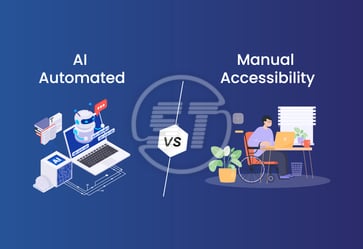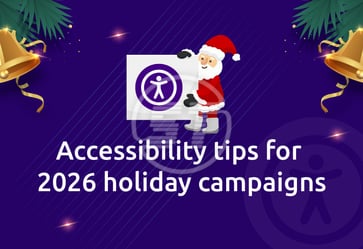Web Accessibility is not only for people with disabilities but for all of us who are thankful that there are no barriers in using our abilities.- Remberto Esposa Jr.
Thus, web accessibility is crucial for every web user. Keeping this very perspective in mind, W3C updated Web Content Accessibility Guidelines (WCAG) and published the latest version (WCAG 2.2) on October 5, 2023.
This version of global accessibility standards aims to make digital content more accessible for people with disabilities. Whether a web developer, designer, content creator, or business owner, understanding WCAG 2.2 is essential to build inclusive and legally compliant digital experiences.
Want to know more about WCAG 2.2?
Read the article!
Frequently asked questions about latest WCAG 2.2 and their answers!
- What is WCAG 2.2?
As written above, WCAG 2.2 is the latest version of the Web Content Accessibility Guidelines. It builds on WCAG 2.1, introducing nine new success criteria to improve accessibility, particularly for users with cognitive disabilities, low vision, and mobility impairments.
- Is WCAG 2.2 backward compatible?
Yes, it is. Since this new version is created on WCAG 2.1, which was inherited from WCAG 2.0. Thus, if a site meets WCAG 2.2, it automatically complies with previous versions.
- Why was WCAG 2.2 released?
It addresses gaps in previous guidelines, especially focusing on cognitive accessibility, mobile usability, and better support for users with disabilities like ADHD or limited fine motor control.
- How many total success criteria are there in WCAG 2.2?
With the addition of 9 new criteria and the removal of only 1, there are 86 success criteria in WCAG 2.2.
- What are these new success criteria?
The new success criteria are:
- 2.4.11 Focus Not Obscured (Minimum) (AA)
- 2.4.12 Focus Not Obscured (Enhanced) (AAA)
- 2.4.13 Focus Appearance (AAA)
- 2.5.7 Dragging Movements (AA)
- 2.5.8 Target Size (Minimum) (AA)
- 3.2.6 Consistent Help (A)
- 3.3.7 Redundant Entry (A)
- 3.3.8 Accessible Authentication (Minimum) (AA)
- 3.3.9 Accessible Authentication (Enhanced) (AAA)
- What level of compliance is required by law?
Most regulations, like the ADA in the U.S. or EN 301 549 in the EU, refer WCAG 2.1 AA for digital compliance. However, WCAG 2.2 AA is becoming the new benchmark as governments update their standards for digital accessibility.
- Do organizations need to update from WCAG 2.1 to 2.2?
While not legally required yet, it is highly recommended. Updating shows a proactive commitment to accessibility and may help future-proof the digital properties.
- What is “Focus Not Obscured”?
This newly added criterion ensures that keyboard focus indicators are always visible and not hidden behind sticky headers or overlays, which is important for keyboard-only users.
- What does “Target Size (Minimum)” refer?
This criterion requires clickable targets (like buttons or links) to be at least 24x24 CSS pixels, reducing accidental taps on small elements, especially on mobile.
- What is “Redundant Entry”?
Users should not have to enter the same information multiple times in a process (like filling out forms). Systems should remember or auto-populate previously entered data when possible.
- Why is “Accessible Authentication” important?
It ensures that users can log in without solving cognitive puzzles like CAPTCHAs or solving math problems - unless there is an accessible alternative.
- How does WCAG 2.2 help users with ADHD or cognitive disabilities? WCAG 2.2 adds criteria that reduce repetition, improve consistency, and simplify interactions. It makes users’ tasks easier to complete and less mentally demanding.
- Are CAPTCHAs banned in WCAG 2.2?
Not really banned but discouraged unless they are accessible. For example, text-based logic puzzles (like “what is 4+5”) often fail accessibility tests under 3.3.8 and 3.3.9.
- What tools can help with WCAG 2.2 audit?
Some of the popular tools for audit include:
- Free Website Accessibility Checker (FWAC)
- WAVE
- Axe DevTools
- Lighthouse
- NVDA/VoiceOver for screen reader testing
- Is WCAG 2.2 only for websites?
No, it applies to web content, mobile apps, intranet portals, and software interfaces – any and every digital product delivered via a user interface.
- What are the three WCAG conformance levels?
- Level A – Minimum accessibility
- Level AA – Standard target for compliance
- Level AAA – Highest level, often not fully attainable for all content.
Find out the difference between WCAG Compliance Level AA and AAA.
- How does an organization test for WCAG 2.2 compliance?
They should follow a process: Use automated accessibility tools like free accessibility checker, manual keyboard testing, screen reader evaluations, and real user feedback. A mix of automated and manual audit is work better.
- Is WCAG 2.2 legally binding?
WCAG itself isn’t law, but various laws refer or adopt it, making it effectively mandatory. Examples: ADA (US), AODA (Canada), EAA (EU), and many more.
- Can AI help with WCAG 2.2?
AI-driven tools like All in One Accessibility® provide real-time automated adjustments, though they should not replace manual audits and remediation. Expert intervention is always recommended to avoid unwanted errors.
- How often should accessibility be tested?
This is irrespective of the WCAG version being used. Accessibility testing is important. Test at least:
- Quarterly for high-traffic sites.
- After every redesign or major update.
- Before launching new features.
- Does WCAG 2.2 cover PDFs and documents?
Indirectly, yes.
While focused on web content, the same perceivable, operable, understandable, and robust (POUR) principles apply to digital documents. Find our PDF accessibility remediation services.
- What industries are most affected by WCAG 2.2?
Every industry ought to conform with accessibility standards including:
- Government
- Education
- Finance
- Healthcare
- Retail/Ecommerce
These sectors are often under legal obligation to comply.
- How can designers adapt to WCAG 2.2?
- Use larger touch targets.
- Ensure visible focus indicators.
- Maintain form consistency.
- Provide simplified authentication methods.
- Offer help in predictable locations
- What’s the best way to train a team on WCAG 2.2?
- Host accessibility workshops.
- Use W3C documentation.
- Invite accessibility consultants.
- Encourage certifications like CPACC (Certified Professional in Accessibility Core Competencies) or WAS (Web Accessibility Specialist)
- Where can detailed official guidelines of WCAG 2.2 can be found?
Visit the W3C’s official website: Web Content Accessibility Guidelines (WCAG) 2.2
Now read this: European Accessibility Act Deadline: EAA Compliance Guide 2025
Wrapping up
Adopting WCAG 2.2 is not only a checklist for organizations – it’s about making digital spaces usable for everyone. With more inclusive design and development practices, organizations can move closer to a web that serves all users equally, regardless of their physical and cognitive abilities.
If an organization hasn’t started planning for WCAG 2.2 yet now is the time. Begin with a simple accessibility audit, train teams, and update the design systems to reflect the new criteria. It’s not only good for compliance – it’s good for business and humanity.
Need help navigating the latest WCAG 2.2 updates? Skynet Technologies offers expert digital accessibility remediation service to keep your website compliant and user-friendly for everyone. Whether it’s audits, remediation, or ongoing support, we simplify accessibility so you can focus on your business. Reach out at hello@skynettechnologies.com and make your digital presence truly inclusive!


